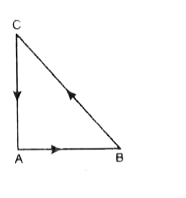Three forces start acting simultaneously on a particle , moving with velocity, →v . These forces are represented in magnitude and direction by the three sides of a triangle ABC (as shown). The particle will now move with velocity
 Solution in Kannada
Solution in Kannada
→v, remaining unchanged
less than →v
greater than
|→v| in the direction of the largest force BC.
The correct Answer is:A
As the forces are represented by the sides of a triangle taken in order their resultant is zero. Hence they produce no change in velocity.
Topper's Solved these Questions
- DESCRIPTION OF MOTION IN TWO AND THREE DIMENSIONBOOK - MODERN PUBLICATIONCHAPTER - DESCRIPTION OF MOTION IN TWO AND THREE DIMENSIONEXERCISE - MCQ(LEVEL-II)
54 Videos
- DESCRIPTION OF MOTION IN TWO AND THREE DIMENSIONBOOK - MODERN PUBLICATIONCHAPTER - DESCRIPTION OF MOTION IN TWO AND THREE DIMENSIONEXERCISE - MCQ(LEVEL-III)(Questions from AIEEE/ JEE Examinations)
6 Videos
- DESCRIPTION OF MOTION IN ONE DIMENSION BOOK - MODERN PUBLICATIONCHAPTER - DESCRIPTION OF MOTION IN ONE DIMENSION EXERCISE - Revision Test
45 Videos
- E.M. INDUCTION AND A.C. CURRENTS BOOK - MODERN PUBLICATIONCHAPTER - E.M. INDUCTION AND A.C. CURRENTS EXERCISE - RECENT COMPETITIVE QUESTIONS
31 Videos
Similar Questions
The vector sum of two forces is perpendicular to their vector differences. In that case, the forces :
View SolutionA particle of mass W is projected with a velocity V making an angle of 30° with the horizontal. The magnitude of angular momentum of the projectile about the point of projection when the particle is at its maximum height H is:
View SolutionThe acceleration of a particle increasing linearly with timer is be. The particle starts from the origin with an initial velocity, The distance travelled by the particle in time will be
View SolutionThere is a uniform magnetic field directed perpendicular and into the plane of the paper. An irregular shaped conducting loop is slowly changing in to a circular loop in the plane of the paper. Then
View SolutionThree forces start acting simultaneously on a particle moving with velocity, ¯v. These forces are respresented in magnitude and direction by the three sides of a triangle ABC. The particle will now move with velocity

View SolutionA particle moving with velocity vecV is acted by the three forces shown by the vector triangle PQR. The velocity of the particle will :
View SolutionWhat is the direction of the force acting on a charged particle q, moving with a velocity →v a uniform magnetic field →B ?
View Solutionतीन बल →v वेग से चलने वाले कण पर एक साथ कार्य करते हैं । इन बलों के परिमाण और दिशा को त्रिभुज ABC की भुजाओं द्वारा दर्शाया जाता है । कण a का नया वेग होगा -

View Solution"if the magnitudes and direction of three forces acting on a particle are represented by three sides of a triangle taken in order, the particle remains in equilibrium" state whether the statement is true or false ?
View Solutionसदिश त्रिभुज PQR में दर्शाए अनुसार वेग →V से गतिमान किसी कण पर तीन बल कार्य कर रहे हैं इस कण का वेग

View SolutionWhat is the direction of the force acting on a charged particle q, moving with a velocity vec(v) a uniform magnetic field vec(B) ?
View SolutionThree forcesstart acting simultaneously on a particle moving with a velocity →v . These forces are represented in magnitude and direction by three sides of a triangle taken in the same order. What now will be the velocity of the particle ?
View SolutionA particle moving with velocity →V is acted by the three forces shown by the vector triangle PQR. The velocity of the particle will :

View SolutionThree forces start acting simultaneously on a particle moving with velocity, →v. These forces are respresented in magnitude and direction by the three sides of a triangle ABC. The particle will now move with velocity

View SolutionAn object under the influence of three forces vec v Speeds up. If the direction of these three forces is shown parallel to the side of triangle ABC, then velocity
View SolutionA particle moving with velocity →V is acted by the three forces shown by the vector triangle PQR. The velocity of the particle will :

View Solution
